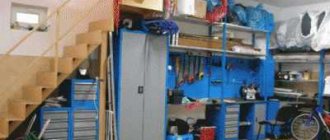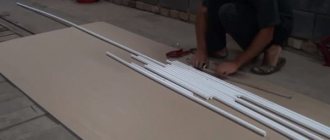Maintaining a positive temperature in the garage is necessary not only for the comfort of its owner, but also to ensure the safety of the car. Therefore, the question of how to heat a garage: with electricity, gas or wood always remains relevant. A network connection is almost always available in a given room, but using this resource is not a very economical method of heating. Equipment operating on solid fuel requires the constant presence of the user to ensure timely loading. As a result, gas heating remains, which is worth considering in more detail.
Advantages and disadvantages
If the garage is located on the territory of a private house, it can be quickly and easily connected to a water system powered by a boiler. This is the best option. However, if the building is autonomous, heating the garage with gas still has many advantages
- Low fuel cost. Especially compared to electricity.
- Economical consumption. Maintaining the required temperature in a small room does not require much energy.
- Possibility of organizing an autonomous system. The equipment used in this case does not depend on the voltage supply; there is also no need to pull the line, since fuel can be purchased in a cylinder.
This heating method also has a number of disadvantages.
- strict adherence to safety precautions during installation and operation, since gas heating of the garage is associated with a fire hazard
- the need to organize supply and exhaust ventilation, arrangement of a chimney to remove combustion products
- higher cost of units compared to electric, solid fuel analogues
Gas heaters
Gas furnaces are often used to heat garages in winter.
On sale, gas heaters are presented in three types of devices:
- IR heater with ceramic burner. Such devices do not require a combustion product removal system.
- Convection type units with a closed combustion chamber. Requires a chimney.
- Heat gun. Ideal for short-term heating of a room.
Today, on the modern market of climate control equipment, catalytic models of gas heaters that operate on the principle of gas oxidation with oxygen are widely represented. The only disadvantages are the high cost of the equipment and the need to install a fire alarm system.
You can make a gas stove for your garage with your own hands; fortunately, there are a huge number of diagrams and instructions for creating one yourself. It should be understood that any mistake in the manufacture of such a unit can lead to a gas explosion, fire, property damage and human casualties, so it is better not to take risks and purchase a finished product from a reputable manufacturer.
The principle of operation of gas equipment for heating a garage
The operation of any device is based on the technology of converting the energy of burned fuel into heat, which is transferred directly to air or water, which carries it to radiators through a pipeline network. This process takes place in a special insulated chamber equipped with a burner. It can be open, when oxygen is taken from the room to maintain the flame, or closed, when the intake is from the street.
It is necessary to ensure a constant supply of fuel to the equipment. In this case, two options are possible: heating the garage with gas from propane cylinders or from a centralized main. The second method is less applicable, although the natural resource supplied through communications is cheaper. Its unpopularity is explained by the difficulty of connecting and obtaining the appropriate permits. As a result, the hassle is not worth the scale of the problem.
Propane gas boiler for garage
This unit is equipped with a coil heat exchanger, in the pipes of which water circulates, then enters the heating devices through the piping. Its use for heating is associated with increased costs for the purchase of equipment, fittings and its installation. The car owner will have to equip the whole system, which is not always rational in a small space. In addition, a gas boiler using bottled propane for heating a garage with piping and communications takes up quite a lot of space. The best option here is to choose a wall-mounted model.
If, nevertheless, a decision has been made to install a water heating complex, it is important to remember that in winter, when the unit is turned off, the coolant can freeze and rupture the pipes. Therefore, the system must function continuously.
Gas stove with cylinder
It is a more compact unit that operates without an intermediate link in the form of a coolant. The space is heated directly from the burner flame. Due to the fact that it is isolated from contact with the user, the equipment is safe. Many devices use infrared wave technology in their work. To do this, they are equipped with a ceramic plate, which, when heated to a high temperature, begins to generate infrared radiation. Its peculiarity lies in the targeted impact not on the air, but on specific objects, people, walls.
You can use garage heating with an IR heater from a gas cylinder at any temperature, which is especially important in the winter. Periodic activation as needed is also acceptable. This will significantly reduce fuel consumption. At the same time, it will be possible to warm up the room to the required temperature using infrared technology extremely quickly.
Gas furnaces are available in a wide variety of models with mobile floor or wall, ceiling stationary installation. This will allow you to choose the best option for a building of any size.
Homemade heater
DIY equipment is also suitable for a small garage space. It will provide heating due to convection and infrared radiation at the same time. To assemble it you will need
- burner
- galvanized steel sheets
- steel mesh
- hemispherical metal sieve
To assemble gas equipment for heating a garage, you need to prepare a hacksaw or grinder, as well as fasteners for connecting elements, for example, rivets, bolts.
Two circles are cut out of the sheets, the diameter of which corresponds to the size of the sieve with a margin. Their edges are folded to allow the attachment of other elements. The burner is fixed on one of the workpieces. The entire structure is then covered with a sieve, whose function is to dissipate heat. A cylinder is rolled up from the mesh to act as a body. On one side, the first circle with a burner is attached to it, on the other, the second workpiece. The resulting unit is connected to a propane cylinder through a hose.
Homemade gun
Its manufacturing technology is even simpler. To do this, you will need a fire extinguisher, from which you need to cut the bottom, or a pipe with a diameter of approximately 200 mm, a fan with a switch, a burner, and a steel mesh. A flame generator is mounted inside a cylindrical container. A fan is installed at one end, and a mesh is installed at the other to protect against open fire. The burner is connected to the cylinder through an adapter pipe.
Convector
When answering the question of how to effectively heat a garage with gas in winter, you should pay attention to this equipment. It heats the space due to the constant movement of air currents: heated ones rise to the ceiling, cooled ones fall to the floor. Its virtues
- high power. One unit is enough to heat the entire room
- compactness. The cylinders to which it is connected can be placed outside behind a wall
- efficiency. Convectors make maximum use of the heat generated during combustion
- minimum amount of emissions into the atmosphere
- easy installation with wall mount
The disadvantages of the devices include the fact that they create additional dust in the room due to the circulation of air flows.
Assembling a horizontal stove-stove
Stages of assembling a horizontal stove from a gas cylinder:
1. The upper part, where the valve was previously located, is cut off from the cylinder at the level of the “shoulders”.
2. Legs are welded to the cylindrical body, which give the stove stability in a horizontal position.
3. A round hole is made in the upper part of the body from the closed end, to which the chimney will be connected in the future. After that, a ring “collar” is welded over the hole, which is made from a strip of steel 5 cm wide.
4. Horizontal grate bars are installed inside the cylinder, the distance from which to the bottom point of the body circumference should be equal to ¼ of the cylinder diameter. To make the installation process more convenient, you can first make holes in the wall of the cylinder for the grate rods, which are subsequently mounted with a circular weld on the outside. You can install the grates inside the body in another way: by welding two shelves from the corners inside, on which to lay the grates. This option looks more preferable, since replacing burnt-out grates in this case is easier and faster than with tapping.
5. A sheet of steel is welded to the front side of the cylinder, in which an opening is cut for the door and a fitting with a ball valve is welded, which will be used as a blower. The door is attached to the body using hinges and is equipped with a latch for tight closure. There is an alternative option, which requires welding a 10 cm wide ring-shaped belt around the body. In this case, the ring-belt is mounted on both the inside and outside of the body, forming a gap for installing a hemisphere cut from the top of the cylinder, which will serve as a door into the combustion chamber. In this case, the blower is the hole for the valve, equipped with a throttle valve or ball lock.
Horizontal cylinder stove
Such a stove must be installed only on a steel sheet, the width of which is at least a meter and the length of at least one and a half meters, while in front of the door to the combustion chamber there must be a platform at least half a meter long.
How to install gas heating for a garage
First of all, it is important to properly prepare the room for the operation of fire-hazardous equipment. To operate a stove or boiler, it is necessary to allocate a fenced nook with an area of 4 m2 and a height of 2 m. It must have natural lighting from a window or artificial lighting from electricity. It is also necessary to organize air access from the street through a hole in the wall or a ventilation system. Cover the walls of the boiler room with non-flammable material.
To install the floor unit, a low platform is built from brick or concrete mortar. Wall-mounted devices are hung on brackets. In order for heating a garage with a gas boiler to be effective, the heating pipes must be laid at a slight slope towards the movement of the coolant. The second option for providing circulation is integration into the pump system. Installation of any type of device must be carried out with an accurate level check of the housing location. The slightest distortion will affect performance. It is important to maintain a distance of at least 30 cm from the unit to the nearest objects.
Connection to the gas main must be carried out with the involvement of a specialist from the relevant farm. Unauthorized connection to the system is fraught with a fine and forced shutdown. The supply of fuel from the cylinder is not regulated by utility services.
Heating system cost
As already mentioned, heating a garage with natural gas mains is the most profitable in terms of operating costs. Liquefied propane is more expensive. The equipment itself also varies significantly in price depending on the type, power, functionality, etc. Boilers have the highest cost; a low-power model with simple configuration will cost from 10,000 rubles. Convectors and infrared heaters cost approximately the same, from 3,000 rubles. The cheapest way is to make the unit yourself using scrap materials.











